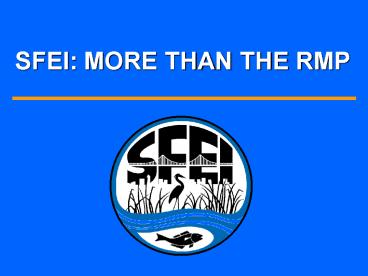SFEI: MORE THAN THE RMP - PowerPoint PPT Presentation
1 / 16
Title:
SFEI: MORE THAN THE RMP
Description:
Napa River Baseline EPA, SWRCB McKee. Bay Area Basemap (NHD) Various Wittner ... a. Assist the Napa RCD and creek groups. b. Report the project at the CALFED ... – PowerPoint PPT presentation
Number of Views:60
Avg rating:3.0/5.0
Title: SFEI: MORE THAN THE RMP
1
SFEI MORE THAN THE RMP
2
SFEIS SCIENCE PROGRAMS
- Contaminants Davis, Thompson
- Wetlands Monitoring Josh Collins
- Watershed Science Lester McKee
- Biological Invasions Andy Cohen
- Supporting Programs
- Historical Ecology Robin
Grossinger - Information Technology Michael May
3
CONTAMINANT MONITORING AND RESEARCH PROGRAM
OBJECTIVE Contribute to the understanding of
contaminant loading, fate, and effects in the
Estuary.
Project Funder PI Grasslands
Bypass USBR Yee CISNet EPA, UCD
Thompson, Davis Aquatic Pesticides SWRCB Siemerin
g PCBs in Effluent WSPA Yee Mercury in
Delta CALFED Davis EMAP NOAA EPA Thompson Tox
icity in Splittail CALFED Davis SRWP Fish
Tissue SRCSD Davis
4
CISNet SAN PABLO BAY STUDY
OBJECTIVE Design a monitoring network that is
temporally and spatially adequate to provide
advance warning of the ecological impacts of
natural and anthropogenic stressors.
Variables Lead Hydrological
Scales UCD Geochemistry Scales UCD Sed. Tox.,
Biomarkers UCD Benthic Assessments SFEI Fish
Tissue Contam. SFEI Corm. Egg Contam.
SFEI Song Sparrow Reprod. PRBO
5
Dioxins in Sediments, 2000 Funded by US EPA
Region IX (Data from J. Pederson, Univ. Wisconsin)
6
AQUATIC PESTICIDE MONITORING PROGRAM
OBJECTIVES Evaluate water quality impacts
associated with application of aquatic
pesticides evaluate effectiveness of Best
Management Practices to reduce or eliminate
impacts.
TASKS 1. Create Organizational Structure
a. Steering Committee, Technical Review Group
b. Management and Assessment Questions 2.
Prepare Aquatic Pesticide Monitoring Plan
a. Literature Review and Synthesis b.
Create Monitoring Plan c. Implement
Monitoring Plan 3. Project Management
a. Quality Assurance, Data Management
b. Reporting
7
CALFED MERCURY PROJECT SPORT FISH
- OBJECTIVES
- Human health concerns
- Long term temporal trends
- Spatial patterns
- Factors influencing mercury in sport fish
- Sampling in 2000 and 2001
- Final Report in Preparation
8
WATERSHEDS PROGRAM
OBJECTIVE Research and map the physical
chemical, biological form and function in a
regional context. Communicate the results to
scientists, managers, and the community.
Prioritize where to place research effort on a
regional basis.
Project Funder PI Napa River Baseline EPA,
SWRCB McKee Bay Area Basemap (NHD)
Various Wittner Storm Drain Map SWRCB McKee Nap
a Stewardship NRCD, CALFED McKee Nutrient
TMDL RWQCB McKee Napa Historical Ecol. Napa
Vintners Grossinger Sonoma Historical
Ecol. Sonoma Ecol. Ctr. Grossinger
9
NAPA STEWARDSHIP SUPPORT
OBJECTIVES Work with the Napa RCD and Carneros
Ck. and Sulphur Ck. stewardships to carry out
watershed assessments necessary to develop
watershed management plans to enhance creek value
SFEI TASKS 1. Stewardship and technical team
meetings to discuss creek values and
multidisciplinary assessment progress 2.
Instream Geomorphology Fieldwork, analysis and
reporting 3. Historical Ecology a.
Landscape flora and fauna b. Instream flora,
fauna, and geomorphology 4. Management plan
development a. Assist the Napa RCD and
creek groups b. Report the project at
the CALFED Science Conference
10
STORM DRAIN MAPPING
OBJECTIVES Improve regional knowledge and
mapping of natural and modified drainage networks
in the Bay Area
TASKS 1. Inventory of GIS coverages 2. Pilot
area (Fremont) and development of
recommendations a. Mapping b. Data and
methodologies 3. NHD (National Hydrography Data
Set) a. Collaborate with USGS b. Complete
Coyote Creek Catalogue Unit 4. Pilot synthesis
of NHD and storm drains maps a. Combine NHD
with storm drain maps developed by Oakland
Museum and William Lettis Associates Inc. b.
Describe methodology and difficulties
11
WETLANDS MONITORING
OBJECTIVES Coordinate design and implementation
of wetlands regional monitoring program,
contribute to scientific basis for wetland
restoration, and enhance coordination of wetland
research.
Project Funder PI Non Indigenous
Plants CALFED Collins Spartina
Monitoring CALFED, CCC Collins WRMP
Development EPA, CCC Collins S F Bay
EMAP EPA Collins Wetland Indicators EPA,
UCD Collins EcoAtlas Info. System CALFED,
Donner Collins, May Contaminant Profiles Rose
Foundation Collins
12
Science Team Approach
- Team Leadership
- Information Technology M. May, SFEI
- Biogeochemistry J. Davis, SFEI
- Physical Processes K. Malamud-Roam,
- Contra Costa MAD
- Vegetation M. Vasey, SFSU
- Invertebrates W. Maffae, Napa MAD
- Fish T. Hopkins, SFBNERR
- Amphibians/Reptiles M. Jenkins, Rana Assoc.
- Birds G. Page, PRBO
- N. Nur, PRBO
- Mammals A. Breaux, SFBRWQCB
- T. Kucera, Kucera Assoc.
- Landscape Ecology M. Kelly, UCB
13
WRMP Components
- Indicator Development
- U.S. CWA Section 104
- U.S. EPA EMAP
- Ambient Status and Trends
- CALFED Science Program
- U.S. EPA EMAP
- Project Performance
- Bair Island
- Crissy Field
- Montezuma Wetlands
- Information Management
- U.S. CWA Section 104
- CALFED Science Program
- BDSC?
14
BIOLOGICAL INVASIONS
OBJECTIVES Provide information on the extent
and impacts of invasions, factors that affect
success of invasions, mechanisms of transport and
release, and the potential for eradication and
control of exotic species.
Project Funder PI So. Calif. Biol.
Study SWRCB, NFWF Cohen Tropical
Invasions Pew Cohen Spartina Invasion NSF,
UCD Cohen, Nordby Ballast Sampling DoD,
NCSU Cohen Zebra Mussel Assessmt. DWR Cohen
15
(No Transcript)
16
(No Transcript)






























